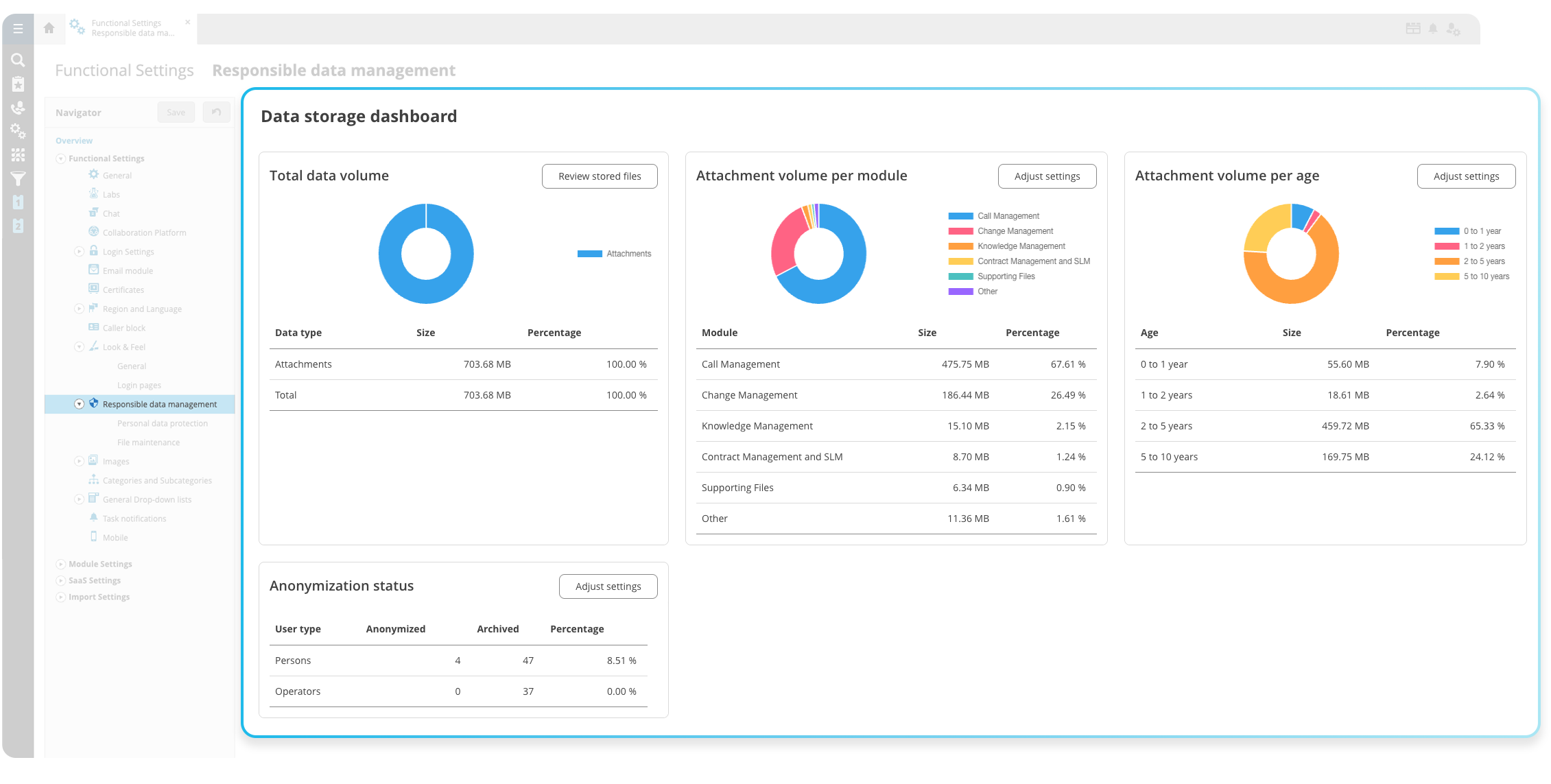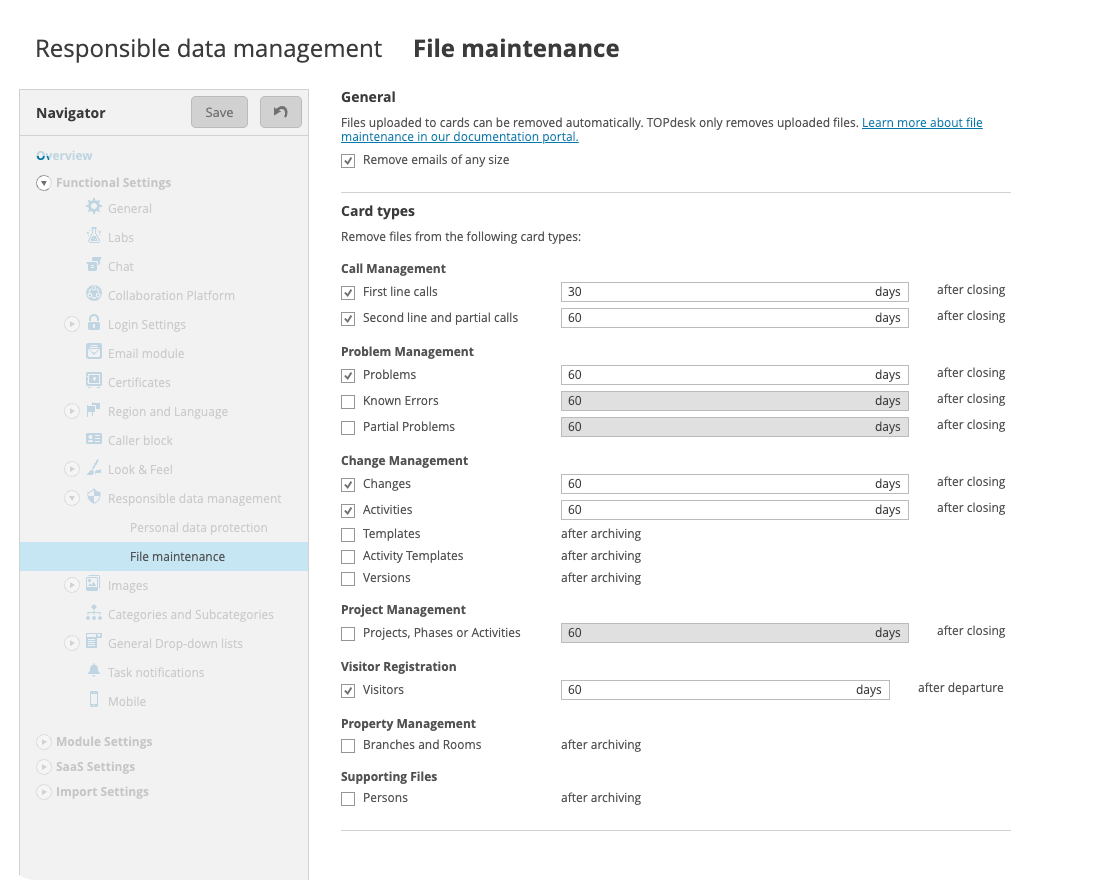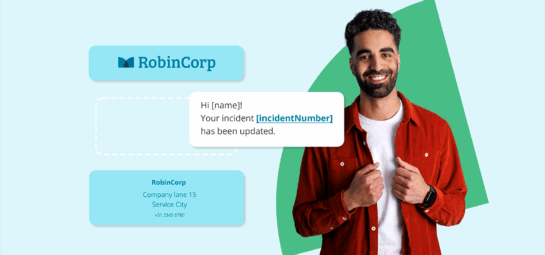How to responsibly manage your data in TOPdesk—without the manual work

Managing your data responsibly isn’t just about complying with privacy laws—it’s about making TOPdesk work more smoothly for your service teams, too. But why not make that work less demanding for you at the same time? With these new features in TOPdesk, you see exactly how much data you’re storing and set up an automated process to clean up that data.
Why clean up your data in TOPdesk?
By deleting files and anonymizing data in TOPdesk, you’re:
- avoiding the repercussions of not complying with data privacy laws
Under data privacy laws, such as GDPR, you’re required to delete files and anonymize personal details for services you’ve finished providing. By turning on the data management settings in TOPdesk, you create an automatic process that speeds up your data privacy checks— and helps you adhere to these laws. - decluttering your TOPdesk environment
By cleaning up your environment in this way, you’re making life easier for your operators. They won’t have to go through irrelevant calls and files anymore when searching for specific information. And the search functionality itself will run more quickly, too. - taking action on corporate social responsibility (CSR)
By only saving relevant information in TOPdesk, you’re helping to reach your organization’s CSR goals as well as our own. If you clean up your data on a regular basis, TOPdesk can reduce the number of servers it uses to store that data and decrease its energy use. - staying in line with your TOPdesk Fair Use Policy
Your organization signed a Fair Use Policy. This policy outlines how much data you can store in TOPdesk: 2 GB per paid operator. With out data management features, you can see how much data you’re storing and reduce that number—so you avoid having to clean up excess data at the last minute.
Improving the existing data management features in TOPdesk
With these four reasons in mind, it’s clear that data management is a crucial process in TOPdesk. That’s why our customers’ feedback via the TOPdesk User Panel put improving the old process high on our product roadmap. The customers on the panel shared that they missed an overview of how much data their organization is storing and anonymizing. They also indicated that the old file removal settings didn’t clearly explain what the consequences of turning on each setting would be—and that they weren’t flexible enough to use. For example, sometimes you need to save data for a longer period of time for specific operator groups.
Based on this feedback, we developed the Data Storage Dashboard. This dashboard gives you more insight into how your organization is managing its data. And if you want to act on that information, we’ve also improved the information and guidelines linked to the file removal settings. In this way, you know exactly how to set up a process in line with your organization’s needs. Our final improvements—the more granular data removal options—are coming in the third quarter of 2025.
The Data Storage Dashboard: discover how you’re managing your data
If you want to manage your data in TOPdesk responsibly, you first need to know what types of data you’re storing and how much space it’s taking up. After all, you can only take effective measures once you know all the ins and outs.
The new Data Storage Dashboard helps you get a clear overview of that information. If you go to Settings > Functional Settings in TOPdesk, you’ll find it under the ‘Responsible data management’ tab.
It shows you:
- your current data storage status. For example, you can see if most of your stored files are uploaded to incidents or knowledge management. Or you can get more insight into how old all your stored files are.
- the anonymization status of people and operators in TOPdesk. You can see how many operators and persons are archived, but still have visible personal details in TOPdesk.
Based on this information, you can identify which parts of the clean-up process you need to tackle first.
File Removal settings: clean up your files—without the manual work
Over time, you and your colleagues store a lot of data in TOPdesk that’s confidential or becomes irrelevant later. For example, an end user might add screenshots of an error message on their laptop to a call. That screenshot becomes obsolete once the call’s been solved—and it also contains personal details and other sensitive information.
Luckily, TOPdesk has two tabs in its data management settings that help you clean up your data and files.
In the Functional Settings, under the ‘Responsible data management’ tab, you’ll find the sub-tabs ‘Personal data protection’ and ‘File maintenance’. You can use the settings in these sub-tabs to automatically clean up your data and files per TOPdesk module, choosing when you want to have outdated information anonymized and/or deleted. This automatic process greatly reduces the manual work you need to do to comply with data privacy laws and declutter your TOPdesk.
And don’t forget: starting in Q3 2025, you’ll be able to clean up files in an even more granular way. Stay tuned!
Frequently Asked Questions
1. I’m scared to lose data if I turn on these settings. Should I be worried?
No, there’s no need to worry. We primarily designed the file removal and anonymization features to clean up personally identifiable information. By turning on the settings, you’re removing obsolete data while also taking responsibility for and fulfilling your obligations under data privacy laws.
That said, you do need to prepare carefully before turning on these settings. It’s important to check which laws apply to your organization, such as GDPR and your national laws. You also need to consider which other regulations and company policies you have to comply with, like your organization’s data privacy policy. These laws and regulations all determine how long your organization is required to store data (the so-called data retention period).
2. Some data could help solve incidents in the future. Can we still access that information if we start automatically removing files?
Yes, you can, but it might require you to change your process.
First things first: you and your team can still access all anonymized cards. The default anonymization functionalities only remove personally identifiable information from TOPdesk cards, emails, and attachments—all in line with the settings you’ve chosen. But deleted files will indeed no longer be accessible.
That’s why you can store any useful information from closed incidents in TOPdesk Knowledge Management. This is a central knowledge base where you can collect information in knowledge items—ready for sharing with your end users and colleagues. Once you’ve prepared the information and stripped it of any personal data, your end users can access it themselves through the self-service portal, while your colleagues can use it to resolve future requests.
One important thing to note is that TOPdesk excels at supporting your service delivery. It’s built to solve incidents and share knowledge. But if you need to archive data and files long-term instead—for example, for 20 years or more—we recommend looking into a document management system.
Want to learn more about making your service delivery more efficient with Knowledge Management? Feel free to reach out to your consultant or account manager. They’re always happy to help!
3. I don’t know what will happen when I turn on these settings. Can you give me some more insight?
If you go to TOPdesk and explore the file removal and anonymization settings there, you can find extra information and guidelines for every step of the process. You can open the supporting documentation for each setting in those tabs as well.
4. Can’t you turn on these settings for me?
Unfortunately, we can't. TOPdesk is the perfect tool to help your organization comply with data protection laws and regulations. But ultimately, you’re responsible for knowing which laws and regulations apply to your organization and which retention periods you should adhere to. For a more extensive explanation, please read knowledge item KI 18479 on My TOPdesk.
Get started with data management in TOPdesk
Managing your data responsibly doesn’t only help you comply with data privacy laws—it also helps your colleagues find information faster. The Data Storage Dashboard and file management settings make cleaning up your data a breeze, giving you the insights you need and automating the clean-up process.
Want to kick off your data management journey today? Start by checking how much data your organization is storing via your Data Storage Dashboard. If you want to take action immediately, go to the settings in your TOPdesk environment and turn on file removal and anonymization today.
Inspire others, share this blog





